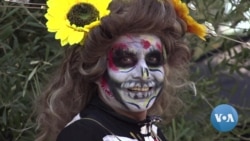ໃນຂະນະທີ່ເດືອນຕຸລາ ຜ່ານໄປຮອດເດືອນ ພະຈິກ, ຫຼັງຈາກວັນ ຮາໂຮວີນ, ການສະເຫຼີມສະຫລອງວັນລະນຶກເຖິງຜູ້ທີ່ເສຍຊີວິດ ຫຼື Day of the Dead ໃນຊຸມຊົນຊາວອາເມລິກັນເຊື້ອສາຍເມັກຊິໂກໃນທົ່ວສະຫະລັດ ຈະຖືກຈັດຂຶ້ນເພື່ອລະລຶກເຖິງຄວາມຊົງຈໍາທີ່ມີກຽດຕໍ່ຜູ້ທີ່ພວກເຂົາເຈົ້າຮັກ ເຊິ່ງໄດ້ ເສຍຊີວິດໄປແລ້ວນັ້ນ. ຈີເນຍ ດູລົດ (Genia Dulot) ໄດ້ໄປຢ້ຽມຢາມງານ ຫນຶ່ງໃນງານທີ່ໃຫຍ່ທີ່ສຸດ, ເຊິ່ງມີຊື່ວ່າ ເດຍ ເດ ລອສ ມູເອີໂຕສ (Dia de los Muertos) ໝາຍຄວາມວ່າ ວັນຂອງຜູ້ທີ່ໄດ້ເສຍຊີວິດ ຢູ່ທີ່ສຸສານ Hollywood Forever ໃນນະຄອນ ລອສ ແອນເຈີລິສ, ທິບສຸດາ ມີລາຍລະອຽດ.
ທຸກໆປີສໍາລັບວັນ ເດຍ ເດ ລອສ ມູເອີໂຕສ ຫຼື ວັນຂອງຜູ້ເສຍຊີວິດ, ທ້າວ ອິສມາເອລ ຣາມີເຣສ ເຮີຕາໂດ (Ismael Ramirez Hurtado) ປະດິດ ເຄື່ອງແຕ່ງກາຍ ລາ ແຄັດທຣິນາ (La Catrina) ໃໝ່ ແລະ ອອກໄປນອກ ນຸ່ງເຄື່ອງທີ່ເປັນສັນຍາລັກທີ່ຈື່ໄດ້ດີທີ່ສຸດແບບນີ້ເພື່ອລະນຶກເຖິງແມ່ຂອງລາວ, ແມ່ຜູ້ທີ່ບໍ່ເຄີຍໝົດຄວາມຮັກສຳລັບລາວ, ລາວເວົ້າວ່າ, ໂດຍສະເພາະ ໃນເວລາ ທີ່ລາວບອກແມ່ຂອງລາວວ່າ ລາວເປັນເກ.
ທ້າວເຮີຕາໂດ ກ່າວວ່າ:
"ເວລາຂ້ອຍບອກແມ່ຂອງຂ້ອຍ, ເຊິ່ງເປັນບຸກຄົນທີ່ມີຄວາມສໍາຄັນກວ່າໝູ່ທີ່ຕ້ອງຮູ້, ລາວກ່າວວ່າ: 'ເຈົ້າເປັນລູກຊາຍຂອງຂ້ອຍ, ຂ້ອຍຮັກເຈົ້າດັ່ງທີ່ເຈົ້າ ເປັນ.’"
ນັກຮຽນມັດທະຍົມປາຍໃນລັດຄາລິຟໍເນຍ ທ້າວແອນໂຕນີໂອ ອາໂຣໂຢ (Antonio Arroyo) ເປັນຜູ້ນໍາກຸ່ມເຕັ້ນ ໂຈເວເນສ ອາເລເກຣສ (Jovenes Alegres), ສະແດງການເຕັ້ນແບບດັ້ງເດີມຂອງຊາວເມັກຊິໂກ ຈາກລັດ ມີໂຈອາຄານ (Michoacán) ເພື່ອລະນຶກເຖິງພໍ່ຂອງລາວ ຜູ້ທີ່ເສຍຊີວິດໄປ ແລ້ວ, ເຊິ່ງເປັນຊາວອາເມລິກາລຸ້ນທຳອິດທີ່ກ່າວວ່າ ການເຕັ້ນເປັນວັດທະນະ ທໍາທີ່ສໍາຄັນໃນການເຊື່ອມຕໍ່ວັດທະນະທຳກັບຕົ້ນກໍາເນີດຂອງລາວ.
ທ້າວແອນໂຕນີໂອ ອາໂຣໂຢ, ຜູ້ຮ່ວມງານດັ່ງກ່າວ ກ່າວວ່າ:
"ປະເພນີດັ້ງເດີມ ຮ້ອງວ່າ 'ເຄີປີເຕັສ' (Kurpites), ຫຼື ດານຊາ ເດີ ເຄີປີເຕັສ ເດີ ແຊນ ຮວນ ນູເອໂວ (Danza de Kurpites de San Juan Nuevo), ແລະທຸກສິ່ງທີ່ພວກເຮົາກໍາລັງນຸ່ງ, ແມ່ນມາຈາກທີ່ນັ້ນ, ມາຈາກ ແຊນ ຮວນ, ເຊິ່ງພວກເຂົາເຈົ້າປະດິດທຸກໆຢ່າງຂຶ້ນມາດ້ວຍມື."
ມື້ທຳອິດຂອງງານ ວັນຂອງຜູ້ທີ່ໄດ້ເສຍຊີວິດ ຢູ່ທີ່ສຸສານ Hollywood Forever ໄດ້ຈັດຂຶ້ນເມື່ອ 24 ປີທີ່ຜ່ານມາ. ມັນໄດ້ຂະຫຍາຍຈາກໂຕະບູຊາ 3 ໜ່ວຍ ແລະຜູ້ເຂົ້າຮ່ວມ 200 ຄົນເປັນຫຼາຍກວ່າ 100 ໂຕະບູຊາ ພ້ອມດ້ວຍ ບັນດານັກທ່ອງທ່ຽວອີກຫຼາຍພັນຄົນ ແລະປັດຈຸບັນ ຖືກຈັດຂຶ້ນໃນນະຄອນ ລອສ ແອັເຈີລິສ, ເຊິ່ງມີປະຊາກອນຊາວອາເມຣິກັນ ເຊື້ອສາຍເມັກຊິໂກຈໍາ ນວນຫຼາຍ.
ທ່ານນາງເຊລີນ ມາເຣສ (Celine Mares) ຜູ້ຮ່ວມກໍ່ຕັ້ງງານ Day of the Dead ຢູ່ ສຸສານ Forever Hollywood ກ່າວວ່າ:
"ຢູ່ໃນ ລອສ ແອນເຈີລິສ ນີ້, ປະຊາກອນທີ່ອາໄສຢູ່ອ້ອມແອ້ມບໍລິເວນດັ່ງກ່າວ ພາກັນໃຫ້ຄວາມສົນໃຈອີຫຼີ ເພາະວ່າບໍ່ມີຫຍັງທີ່ເປັນລັກສະນະນີ້ເກີດຂຶ້ນຢູ່ໃນສຸ ສານໃນ ລອສ ແອນເຈີລິສ."
ນາງກ່າວວ່າ ເຖິງແມ່ນຈະເປັນມໍລະດົກທາງວັດທະນະທໍາເມັກຊິກັນຂອງນາງ ກໍຕາມ, ນາງກໍບໍ່ໄດ້ເຕີບໃຫຍ່ຢູ່ໃນ ສະຫະລັດ ດ້ວຍວັດທະນະທໍາທີ່ມີຊີວິດຊີວາ ຂອງນາງ. ນາງຕ້ອງການທີ່ຈະປ່ຽນແປງສິ່ງນັ້ນ ສໍາລັບຊາວ ອາເມຣິກັນ ເຊື້ອສາຍເມັກຊິໂກ ລຸ້ນທີ່ໜຸ່ມນ້ອຍກວ່າ.
ຄູສອນການສຶກສາພິເສດ ທ່ານນາງ ເຈນນີ ໂມຣາເລສ (Jenny Morales), ຍັງເປັນຊາວອາເມລິກາລຸ້ນທໍາອິດ, ທີ່ໄດ້ສ້າງໂຕະບູຊານີ້ສໍາລັບຄວາມຊົງຈໍາ ຂອງສະມາຊິກຢູ່ໃນຄອບຄົວມາເປັນເວລາ 6 ປີ ແລະເພື່ອຄົ້ນຫາສັນ ຍາລັກຂອງແມງກະເບື້ອນາງພະຍາ.
ທ່ານນາງ ເຈນນີ ໂມຣາເລສ, ຜູ້ເຂົ້າຮ່ວມງານດັ່ງກ່າວເວົ້າວ່າ:
"ມີນິທານເລື່ອງນຶ່ງຢູ່ໃນເມັກຊິໂກ, ໂດຍສະເພາະໃນ ມິໂຈອາຄານ (Michoacán), ເຊິ່ງເປັນລັດນຶ່ງໃນເມັກຊິໂກ ບ່ອນທີ່ນິທານເລົ່າວ່າ ແມງ ກະເບື້ອນາງພະຍາ ຈະນໍາພາດວງວິນຍານຂອງຄົນຮັກພວກເຮົາທີ່ເສຍຊີວິດ ນັ້ນ. ສະນັ້ນໃນຊ່ວງເວລານີ້ ວັນຜູ້ທີ່ໄດ້ເສຍຊີວິດ, ມັນມີສະຖານທີ່ແຫ່ງນຶ່ງຢູ່ໃນ ມິໂຈອາຄານ, ເຊິ່ງມັນຄ້າຍຄືກັບປູສະນີຍະສະຖານຢູ່ທີ່ນັ້ນ, ມັນຕັ້ງຢູ່ເທິງພູ, ສະນັ້ນ ພວກເຂົາເຈົ້າຈະກັບມາເລື້ອຍໆໃນເດືອນພະຈິກ. ສະນັ້ນ ນິທານແມ່ນ ພວກເຂົາເຈົ້າ (ນາງພະຍາ) ກໍາລັງກັບຄືນມາ, ເຊິ່ງເປັນດວງວິນຍານຂອງຄົນ ຮັກຂອງພວກເຮົາທີ່ເສຍຊີວິດໄປ.”
ໃນຂົງເຂດ ລອສ ແອັງເຈລລິສ, ຊາວ ຮິສປານິກ ຫຼື ຊາວລາຕິນ ປະກອບເຂົ້າກັນເປັນກຸ່ມເຊື້ອຊາດທີ່ໃຫຍ່ທີ່ສຸດ, ເຊິ່ງມີປະມານ 5 ລ້ານຄົນ, ອີງຕາມການຄາດການໃນການຄິດໄລ່ສໍາມະໂນຄົວປີ 2021, ແລະ 75 ເປີເຊັນຂອງພວກເຂົາເຫຼົ່ານັ້ນ ແມ່ນມີບັນພະບູລຸດເປັນຊາວເມັກຊິກັນ.
As October gives way to November, Halloween is followed by the celebration of the Day of the Dead in Mexican American communities across the U.S. to honor the memory of loved ones who have died. Genia Dulot visited one of the largest events, the Dia de los Muertos -- Day of the Dead -- at Hollywood Forever Cemetery in Los Angeles.
Every year for Dia de los Muertos, or the Day of the Dead, Ismael Ramirez Hurtado makes a new La Catrina costume and goes out dressed like this most recognizable symbol of the celebration in memory of his mom, who was never short of love for him, he says, especially when he told her he’s gay.
Ismael Ramirez Hurtado, Event Participant, Male in English
“When I told my mom, the more important person had to know, she said: ‘You are my son, I love you like that.’”
California high school student Antonio Arroyo leads a dance group Jovenes Alegres, showcasing a traditional Mexican dance from the state of Michoacán as a tribute to his father, who died. The first-generation American says the dance is an important cultural connection to his roots.
Antonio Arroyo, Event Participant, Male in English
“Tradition is called ‘kurpites,’ Danza de Kurpites de San Juan Nuevo, and everything that we are wearing, comes from there, from San Juan, and they make everything by hand.”
The first Day of the Dead event at Hollywood Forever Cemetery took place 24 years ago. It has grown from three altars and 200 attendees to more than 100 altars and 20 thousand visitors and is held today in Los Angeles, which has a large Mexican American population.
Celine Mares, Event Co-Founder, Female in English
“Here in Los Angeles the demographics around here really took an interest because there wasn’t anything like that happening in the cemetery in Los Angeles."
She says that despite her Mexican heritage, she didn’t grow up in the U.S. with her culture’s vibrant traditions. She wants to change that for younger generations of Mexican Americans.
Special education teacher Jenny Morales, also a first-generation American, has been creating this altar for the past six years in memory of family members and to explore the symbolism of the Monarch butterfly.
Jenny Morales, Event Participant, Female in English
“There is a legend in Mexico, especially in Michoacán, that’s a state in Mexico where the legend is that the monarch butterfly carries the souls of our passed loved ones. So during this time [Day of the Dead], there is a place in Michoacan, it’s like a sanctuary there, it’s up in the mountains, so they always come in November. So the legend is, they [the monarchs] are returning, the souls of our passed loved ones.”
In Los Angeles County, Hispanics or Latinos comprise the largest ethnic group – nearly 5 million people, according to 2021 Census estimates, and 75% of them are of Mexican ancestry.





